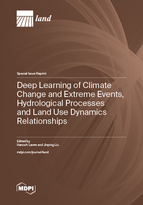Deep Learning of Climate Change and Extreme Events, Hydrological Processes and Land Use Dynamics Relationships
A special issue of Land (ISSN 2073-445X). This special issue belongs to the section "Land Systems and Global Change".
Deadline for manuscript submissions: closed (28 February 2025) | Viewed by 17323
Special Issue Editors
Interests: surface runoff; soil erosion; land use; climate change
Special Issues, Collections and Topics in MDPI journals
2. Hydraulics and Geotechnics Section, KU Leuven, Kasteelpark Arenberg 40, BE-3001 Leuven, Belgium
Interests: extreme climatic events; climate change and human health impacts; hydrology modeling; water resources; vegetation remote sensing
Special Issues, Collections and Topics in MDPI journals
Special Issue Information
Dear Colleagues,
The impact of climate change, particularly the rise in severe extreme events, on hydrological processes, land use patterns, and ecosystem health changes is a critical area of research for understanding and managing the future of our globe. At the same time, changes in hydrological processes and land use, such as decreasing surface flow, deforestation, and urbanization, can contribute to climate change.
With its ability to process large datasets and identify hidden patterns, deep learning has provided new tools for analyzing complex environmental data and developing predictive models. These tools offer a promising avenue for advancing our potential response to environmental challenges.
This Special Issue aims to bring together researchers from diverse fields to apply deep learning methods in investigating climate change, extreme climate events, and their impact on surface flow response and land use changes to enhance our capacity for predicting their inter-relationships and adaptation and mitigating their adverse effects.
We seek to promote the development of new models and tools that can improve our ability to predict and manage complex interactions between the above-mentioned environmental components.
We welcome submissions that address topics including, but not limited to, the following:
- Application of deep learning techniques for predicting extreme climate events and their impact on hydrological process response and land use change.
- Use of deep learning to model the feedback loops between hydrological process response, land use change, and climate dynamics.
- Development of deep learning-based tools for assessing vulnerability and resilience of surface flow processes and land systems to climate change.
- Integration of remote sensing data with deep learning to monitor surface flow and land use changes under extreme climate conditions.
- Deep learning approaches for optimizing hydrological structures, land use planning, and climate adaptation strategies.
- Deep learning enhances the understanding of ecosystem services in the context of climate change, hydrological process response, and land use change.
- Case studies demonstrating the effectiveness of deep learning in managing hydrological structures and land use in the face of extreme climate events.
- Ethical considerations and challenges in applying deep learning to environmental research and decision making.
Prof. Dr. Hanoch Lavee
Dr. Jinping Liu
Guest Editors
Manuscript Submission Information
Manuscripts should be submitted online at www.mdpi.com by registering and logging in to this website. Once you are registered, click here to go to the submission form. Manuscripts can be submitted until the deadline. All submissions that pass pre-check are peer-reviewed. Accepted papers will be published continuously in the journal (as soon as accepted) and will be listed together on the special issue website. Research articles, review articles as well as short communications are invited. For planned papers, a title and short abstract (about 100 words) can be sent to the Editorial Office for announcement on this website.
Submitted manuscripts should not have been published previously, nor be under consideration for publication elsewhere (except conference proceedings papers). All manuscripts are thoroughly refereed through a single-blind peer-review process. A guide for authors and other relevant information for submission of manuscripts is available on the Instructions for Authors page. Land is an international peer-reviewed open access monthly journal published by MDPI.
Please visit the Instructions for Authors page before submitting a manuscript. The Article Processing Charge (APC) for publication in this open access journal is 2600 CHF (Swiss Francs). Submitted papers should be well formatted and use good English. Authors may use MDPI's English editing service prior to publication or during author revisions.
Keywords
- deep learning techniques
- climate change impact
- extreme event forecasting
- hydrological data analysis
- land use change monitoring
- predictive environmental modeling
- remote sensing applications
- disaster risk assessment
- water resource optimization
- ecosystem service evaluation
- sustainable development strategies
- environmental decision support
Benefits of Publishing in a Special Issue
- Ease of navigation: Grouping papers by topic helps scholars navigate broad scope journals more efficiently.
- Greater discoverability: Special Issues support the reach and impact of scientific research. Articles in Special Issues are more discoverable and cited more frequently.
- Expansion of research network: Special Issues facilitate connections among authors, fostering scientific collaborations.
- External promotion: Articles in Special Issues are often promoted through the journal's social media, increasing their visibility.
- Reprint: MDPI Books provides the opportunity to republish successful Special Issues in book format, both online and in print.
Further information on MDPI's Special Issue policies can be found here.







